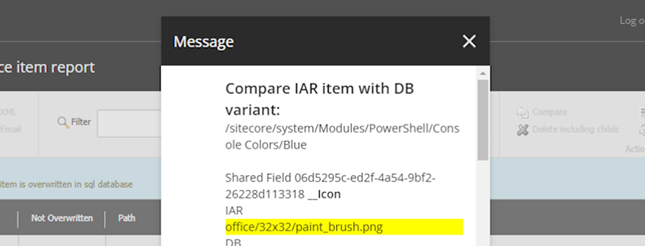- Home
- Tips & Tricks and news
- Sitecore articles and code samples
- Items as resources part 6 multiple files
- Jan Bluemink Sitecore MVP 2024
- Tip Detecting Sitecore XM Cloud in PowerShell
- Unpublish a language from a Sitecore website
- Media url in the content editor - Edge ready
- Sitecore Content Migrating with GraphQL
- Migrating Your Content
- Create a Package Containing Overridden Items
- Items as resources part 5 Gutter
- Items as resources part 4 compare
- SUGCON Europe 2023 recap
- Item as resources PowerShell warning
- Items as resources part 3 restoring
- Sitecore Webhook Customize JSON
- Jan Bluemink Sitecore MVP 2023
- Sitecore switch Solr indexes strategy on SearchStax
- Sitecore Symposium - laatste ontwikkelingen
- Orphan items and Sitecore Items as resources
- Items as resources part 2 reports
- Tip View html cache content
- Tip Sitecore General link picker 404 error
- Items as resources part 1 warnings
- SUGCON Europe 2022 recap
- From MVC to Sitecore Headless Rendering
- Jan Bluemink Sitecore Most Valuable Professional 2022
- Sitecore Launchpad external link
- The end of Sitecore fast query
- Tip Site specific error and 404 page
- Flush Partial HTML on Dictionary changes
- Sitecore content dependencies options for Partial Html Cache
- Custom Partial Html flush event
- Sitecore Partial HTML Cache
- Flush HTML cache on Sitecore Forms Submit
- Sitecore errors you can encounter
- A poll with Sitecore Forms
- Where is the sitecore_horizon_index
- Sitecore Forms virus upload validation
- Sitecore Forms create a poll
- Sitecore NuGet dependencies in Sitecore 10.1
- Sitecore Forms ML upload validation
- Upgrading to Sitecore 10.1
- Jan Bluemink Sitecore Most Valuable Professional 2021
- Symposium 2020 day 1 Developer recap
- Sitecore CLI login error
- Sitecore Content Editor Warning for large images
- Fix Sitecore 10 Docker installation
- Roles and rights changes in Sitecore 10
- Export and Import Sitecore Roles and Rights
- Advanced Image Field Experience Editor
- Azure DevOps Copy Sitecore Database
- Unable to connect to master or target server
- How many times is each rendering used for a specific website
- A potentially dangerous Request
- CSP headers and Content Hub
- Jan Bluemink Wins Sitecore Most Valuable Professional Award
- Sitecore 9.3 Forms process sensitive files
- Sitecore 9.3 Forms Upload export
- How to add a Sitecore admin programmatically
- DAM connector for Sitecore
- Betty Blocks and Sitecore
- Sitecore Cortex Demo Code in 12 minutes
- Scaling Sitecore JSS images
- Caveats with JSS GraphQL endpoint
- Content tagging JSS GraphQL
- Prevent use of PNG media
- JSS Customizing output
- JSS Integrated GraphQL Queries
- JSS Integrated GraphQL Upgrade
- JSS FormatException: DebugOnly
- New user rights in Sitecore 9.1
- Smartling Translation plugin
- JSS Integrated GraphQL
- Forms Serverless Upload
- Language Warning version 9
- Sitecore Forms Extension Pack
- VSTS and Sitecore
- Roles in Sitecore 9
- Sitecore Azure ARM
- Headless Sitecore
- Sitecore Development 2017
- Azure Cognitive Services
- DocumentDB for sessions
- Databases diskspace tips
- Edit Aliases
- Language Warning
- WFFM and secure Fields
- SUGCON 2016
- Sitecore Tips and Tricks 2016
- SEO Processor
- Custom Cache
- What rights are custom
- Replace Content
- Bulk Create Sitecore Users
- Content editor language
- Roles in Sitecore 8
- Wrong language warning
- Change LinkManager config
- Development and deployment
- Language fallback
- SEO XML Sitemap
- Single line Text with HTML
- Sitecore and the error page
- Sitecore Tips and Tricks
- The Experience Editor
- Upgrade and modules
- User friendly developing
- Dialoge box in een Command
- Editen in de juiste taal
- Sitecore en de error page
- Locked items
- About
- Contact

Created: 16 Oct 2023, last update: 4 Apr 2024
Migrating Your Content Seamlessly: A Comprehensive Tech Guide from WordPress to Sitecore XM Cloud
Are you looking to make a smooth transition from WordPress to Sitecore XM Cloud? With the power of The RESTful API for the ItemService from Sitecore, you can effortlessly import your content using your favorite programming language, such as C#. Whether you're switching from WordPress, Umbraco, or any other system that can export data in a usable format like JSON, this blog post is your go-to resource for a successful migration.
Exploring the RESTful API
In this blog, we dive deep into the RESTful API for Sitecore, examining how to import content from simple one-page WordPress layouts into Sitecore. We'll also highlight that the RESTful API for XM Cloud mirrors that of Sitecore XP, making it a versatile tool for your content migration needs.
Content migration options
While the RESTful API is a powerful choice, there are alternative automation options that might be better suited for specific cases, each with its own set of advantages and disadvantages. Here's an overview of the available methods:
Sitecore RESTful API:
- Compatible with XM Cloud and Sitecore XP
- Basic API lacks advanced features
- With C#, it's easy to create logic that formats the data to fit in Sitecore
- Offers a very good Visual Studio debugger
- No issues with long-running processes as a Windows console application
- However, it lacks support for media
Sitecore Authoring and Management GraphQL API:
- Supports XM Cloud and Sitecore 10.3+
- Similar to REST API but includes media support
- A bit more challenging to set up and connect compared to REST API
Sitecore PowerShell:
- Usable for XM Cloud and Sitecore XP
- Runs in the Sitecore context, providing direct access to Sitecore native API
- Out-of-the-box support for long-running processes
- Some users may find it more difficult to write logic in PowerShell than in C#
Custom Import (Running in Sitecore Context):
- Requires creating logic for long-running processes
- Needs deployment to Sitecore for running
- Providing direct access to Sitecore native API
Sitecore Connect:
- Less suitable for one-time tasks
- Can be difficult to connect to the local computer
Choosing the right method
Content migration is typically a one-time task, but it's beneficial if the process is repeatable. For development purposes, easy debugging is crucial. The import can be performed on any Sitecore environment of your choice, and content can be exported using packages or item serialization. In terms of performance, all the mentioned solutions can create a few items per second. However, for XM Cloud, the GraphQL API is often a good choice.
The RESTful API solution
Below I provide tips and solutions for content migration with the Sitecore RESTful API. I will also provide insights into Sitecore Authoring and Management GraphQL API in a future blog post.
Authentication
Username and password… Yes, also on XM cloud. I was a bit surprised but that is how it works, just create a Sitecore account.
Branches
The RESTful API doesn’t support Sitecore Branches Templates, you need to create structure yourself.
Media
The API doesn’t support media uploading. You can store media on disk by creating one or more zip files. Just make sure the file size of the .zip is not much larger than 100Mb, otherwise it will be difficult to process in Sitecore. Use the Advance upload in Sitecore and check ‘unpack zip’. After uploading the media in Sitecore, you can use the RestFul API to check if a media is in Sitecore and you get the Sitecore Item Guid back, which you can use to refer the media.
For a media picker field, you can use this format: <image mediaid="{mediaguid}" />
For using media in rich text, you can use this format: -/media/[mediaguid important without braces and dashes!].ashx
Layout
You can use the __Renderings and __FinalRenderings field for the Layout, just put the layout XML into these fields. If needed you can use the Sitecore.Layout. LayoutDefinition from the Sitecore.Kernel to help construction the layout XML.
Ready to Get Started?
I've got a demo code for you, check out my GitHub repository for practical code that works seamlessly with XM Cloud. To make it work with Sitecore XP, you need to adjust the template GUID and the template models to fit. The code includes authentication, media handling, component management, and tags/references.
Let's get started!




